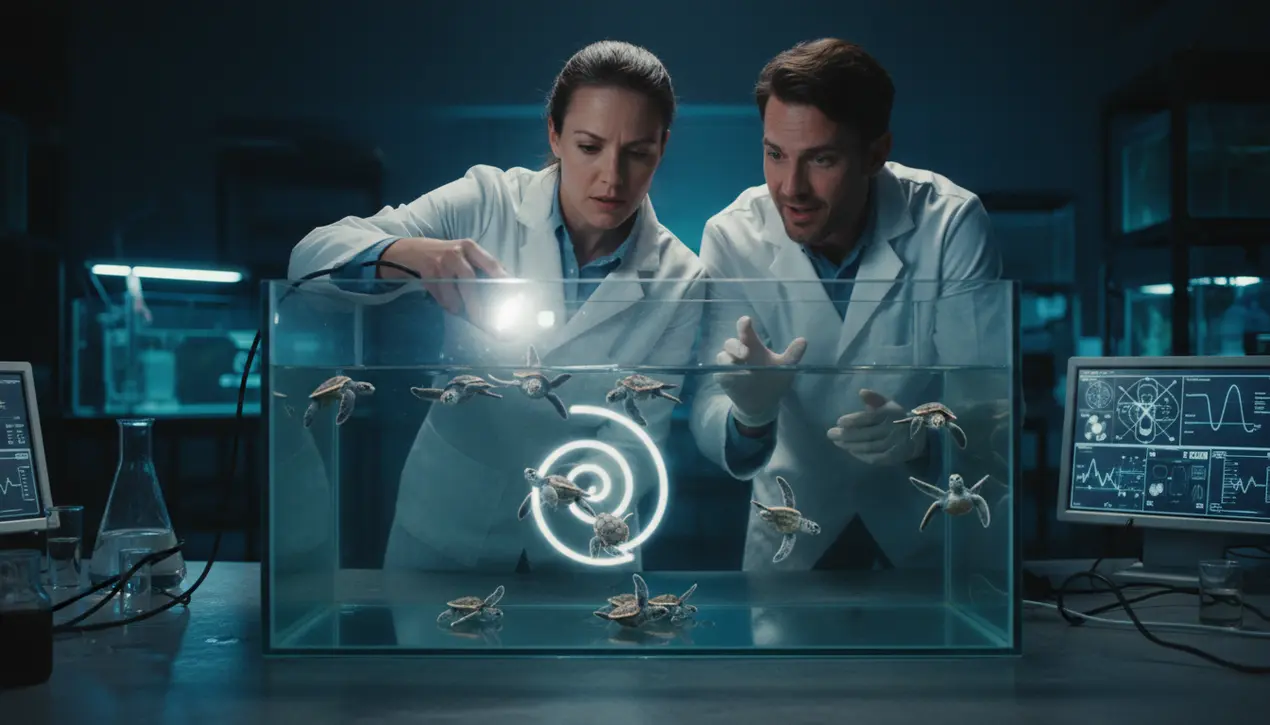- News
- biology
- Scientists reveal how baby turtles navigate thousands of miles with a hidden magnetic sense

SciencebiologyAnimal Behavior
Scientists reveal how baby turtles navigate thousands of miles with a hidden magnetic sense
TH
Thomas Green
12 hours ago7 min read2 comments
In a revelation that feels like it's been pulled straight from the pages of a sci-fi novel, scientists have cracked one of the ocean's most enduring mysteries: how baby loggerhead turtles, no bigger than the palm of your hand, manage to navigate thousands of miles of featureless ocean to find their specific feeding grounds. The answer, it turns out, is a sophisticated, touch-based magnetic sense—a biological GPS system of astonishing precision.Researchers, in a brilliantly designed experiment, essentially taught a cohort of young turtles to associate specific magnetic signatures with the promise of a meal, prompting them to perform a distinctive, celebratory dance upon recognizing the correct signal. The real breakthrough came when scientists applied a brief magnetic pulse, temporarily scrambling the turtles' internal navigational hardware.Suddenly, the dance stopped. The turtles were adrift, their hidden compass disabled.This elegant intervention provided the smoking gun, demonstrating conclusively that these hatchlings don't just have a vague sense of direction; they possess a tactile, magnetoreceptive ability that allows them to 'feel' the planet's magnetic field lines, using this data to pinpoint their global position with an accuracy that would make most modern technology blush. This discovery fundamentally rewrites our understanding of animal migration.For decades, we've marveled at the epic journeys of creatures from monarch butterflies to Arctic terns, often attributing their paths to a combination of celestial navigation and inherited instinct. The loggerhead's case is different.It’s not just about following a set course; it’s about active, dynamic map-reading on a planetary scale. These turtles are born on beaches from Florida to Oman, and immediately upon scrambling into the surf, they embark on a multi-year, transoceanic odyssey known as the 'lost years,' traversing entire ocean basins like the Sargasso Sea and the North Atlantic Gyre before returning to their natal coasts as juveniles.How they avoid getting lost in the vast blue has been a question that has tantalized biologists since the time of Darwin. This research, building on foundational work by pioneers like Kenneth and Catherine Lohmann, who first demonstrated magnetic sensitivity in turtles in the 1990s, moves us from correlation to causation.We now have a clearer window into the sensory mechanism itself. The leading hypothesis points to magnetite-based receptors, tiny particles of magnetic iron oxide that could act like microscopic compass needles within the turtles' cells, likely in their brains or even embedded in their nerve endings, translating geomagnetic information into tactile sensation.Think of the Earth as a giant bar magnet, with field lines flowing from the poles. The intensity and inclination—the angle at which the field lines intersect the Earth's surface—create a unique magnetic signature for every patch of ocean, a kind of latitudinal and longitudinal coordinate system written in invisible ink.The baby turtles are reading this script. This isn't just an academic curiosity; it's a conservation imperative.Understanding this delicate sensory apparatus highlights the profound vulnerability of these ancient mariners. Human-generated electromagnetic noise, from underwater cables to naval sonar, could potentially create a form of 'sensory pollution,' jamming the very signals these creatures depend on for survival.Furthermore, as the Earth's magnetic poles continue their slow but constant wander, a process known as geomagnetic secular variation, the navigational maps hardwired into these animals over millennia are subtly shifting. It raises a profound question: can their evolution keep pace with the changing magnetic landscape? This discovery also opens a cosmic box of possibilities.If loggerheads can feel magnetic fields, what other sensory worlds are closed to us? It hints at a universe of perception operating just beyond the limits of our own senses, a reminder that the animal kingdom experiences reality in ways we are only beginning to fathom. The humble baby turtle, it seems, is not just a swimmer but a master navigator, charting its course across the planet using a force field we can neither see nor feel, a true marvel of evolutionary engineering.
#featured
#baby turtles
#magnetic sense
#navigation
#animal behavior
#research breakthrough
Stay Informed. Act Smarter.
Get weekly highlights, major headlines, and expert insights — then put your knowledge to work in our live prediction markets.
Related News
Comments
Loading comments...
© 2025 Outpoll Service LTD. All rights reserved.